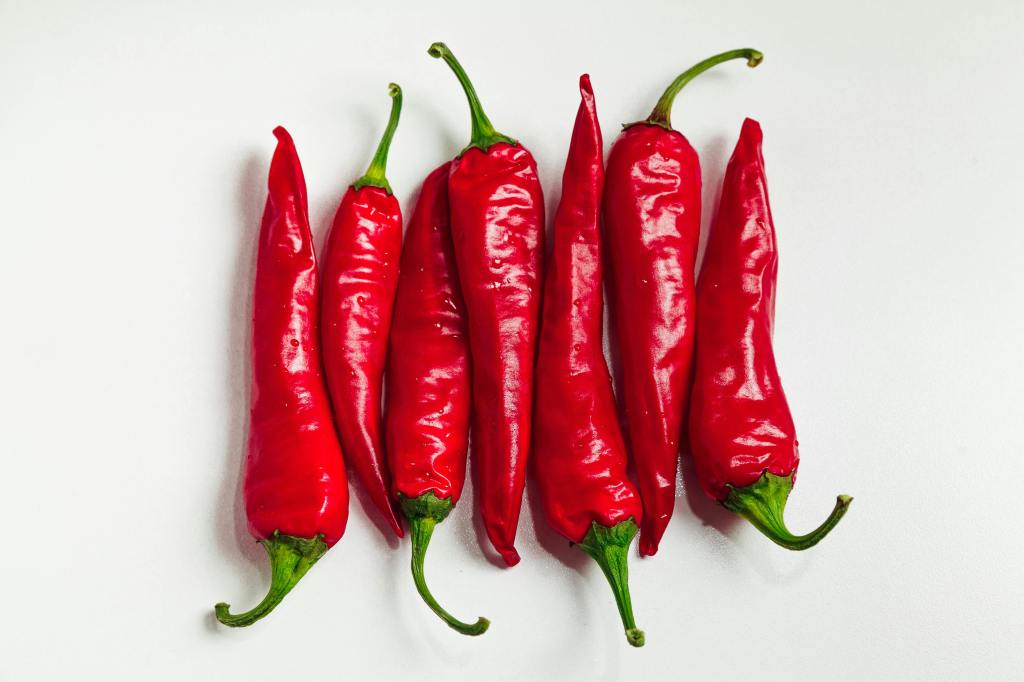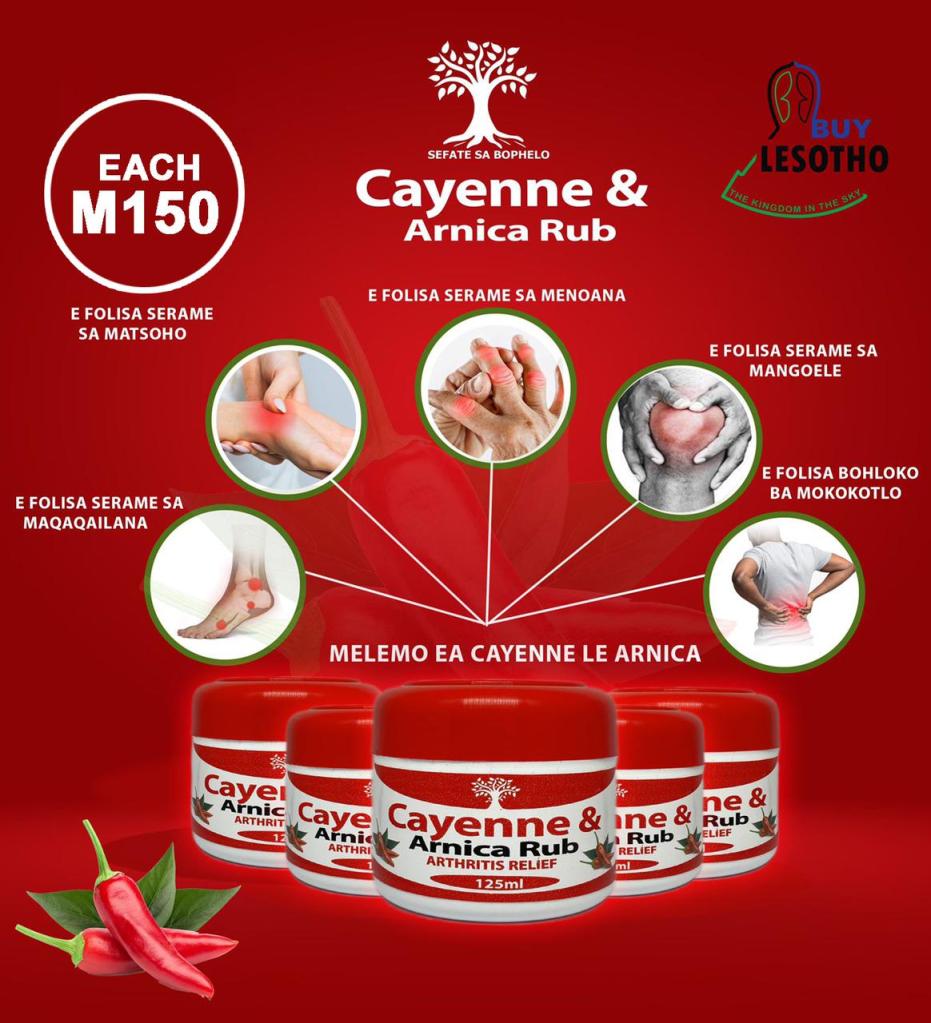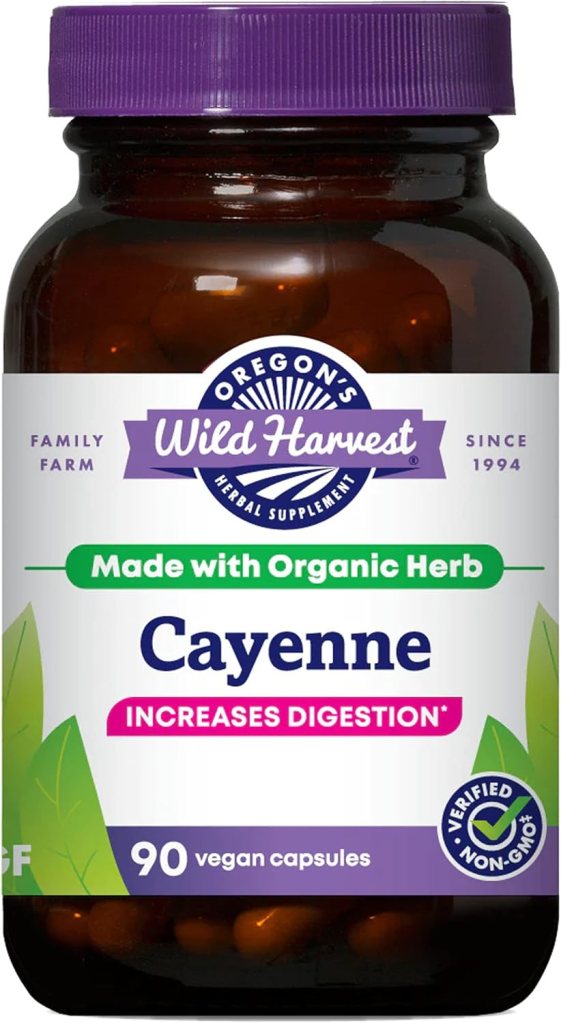Discover the benefits of cayenne pepper for treating coldness and arthritis. Learn how capsaicin, the active compound in cayenne pepper, can improve circulation, reduce inflammation, and alleviate pain.
Explore practical ways to use cayenne pepper topically, as dietary supplements, and in your meals. Consult with healthcare professionals before starting any new treatment. Embrace cayenne pepper’s natural healing properties to enhance warmth and manage arthritis symptoms effectively.
Introduction
Fellow readers hi, this is Marenyane Mokhethi. Imagine living in the mountains of Lesotho, where winter’s chill is relentless, and every breath feels like ice. I suffered from severe coldness and painfully stiff fingers every winter for years. But then, everything changed when I discovered the remarkable benefits of cayenne pepper.
Cayenne pepper, a fiery spice known for its vibrant red color and intense heat, is more than just a kitchen staple. Its active ingredient, capsaicin, is a powerful compound that has been shown to offer numerous health benefits, particularly for those suffering from conditions like coldness and arthritis. Cayenne pepper’s health benefits are vast and varied from improving circulation to reducing inflammation.

I started using cayenne pepper after hearing about its potential to warm the body and alleviate pain. Within days, I noticed a difference. The cold still lingered, but it was no longer the bone-deep chill that once plagued me. My fingers, which had been stiff and painful, began to feel more flexible and less sore.
Realizing that this works, I recommended my mom (above 60 years) to use it since she has been complaining of being cold in her left ankle. She had used it and the next day, she was singing praises about this product. Isn’t that amazing?
Natural remedies like cayenne pepper are gaining popularity as people seek effective and less invasive ways to manage health conditions. The benefits of cayenne pepper extend beyond just adding spice to your food. It’s a natural powerhouse that can help improve your quality of life.
This article will delve into how cayenne pepper can be used to treat coldness and arthritis, backed by science and my inspiring story. We’ll explore the cayenne pepper benefits that can transform your health, including its circulation-boosting and pain-relieving properties. Whether you’re looking to warm up during the cold months or seeking relief from arthritis pain, cayenne pepper might just be the natural remedy you need.
Stay with us as we uncover the incredible cayenne pepper health benefits and how this humble spice can make a significant difference in your life.

Disclaimer
Some of the links provided in this article are affiliate links, which means I may earn a commission if you click on them and make a purchase. This comes at no extra cost to you and helps support the work I do in providing valuable content. Rest assured, all products recommended in this review are carefully selected based on their quality and relevance to the topic.
What is Cayenne Pepper?
Cayenne pepper is a bright red spice that many people use to add heat to their food. It comes from dried and ground chili peppers, which are native to Central and South America. This spice is not just about adding flavor to your dishes; it’s packed with health benefits too.
The magic ingredient in cayenne pepper is called capsaicin. This is what gives it that spicy kick. Capsaicin is known for its powerful health benefits. It can help with things like improving circulation, reducing pain, and even boosting metabolism. People have used cayenne pepper for centuries, not just for cooking but also for its medicinal properties.
Nutritional Profile
Cayenne pepper is low in calories but high in vitamins and minerals. Just one tablespoon of cayenne pepper can provide:
– Vitamin A: Good for vision and immune function.
– Vitamin C: Helps with the immune system and skin health.
– Vitamin E: Important for skin and eye health.
– Vitamin B6: Essential for brain health and metabolism.
– Vitamin K: Important for blood clotting and bone health.
Cayenne pepper also contains antioxidants. These help fight off harmful molecules called free radicals that can damage cells in your body. This is why cayenne pepper health benefits are so widely recognized.
Cayenne Pepper Benefits
1. Improving Circulation: Many people, like me have noticed better circulation after using cayenne pepper. This means feeling warmer in cold weather and having less pain in fingers and toes.
2. Pain Relief: The capsaicin in cayenne pepper can help reduce pain. This is why you’ll find capsaicin in many topical creams for arthritis. Just like I felt relief in his painful fingers, you might find that cayenne pepper can help with sore joints and muscles.
3. Boosting Metabolism: Adding cayenne pepper to your diet can help increase your metabolism, which helps in burning more calories. This can be helpful for weight management.
4. Digestive Health: Despite its spiciness, cayenne pepper can improve digestion. It stimulates the digestive tract and helps produce enzymes and gastric juices that aid digestion.
Using cayenne pepper can be as simple as sprinkling it on your food, adding it to soups and stews, or even taking it in supplement form. Its health benefits make it a great addition to your daily routine.
Cayenne pepper is more than just a spice; it’s a natural remedy with numerous health benefits. Whether you’re looking to warm up, relieve pain, or boost your health, cayenne pepper is worth considering.

How Cayenne Pepper Can Help with Coldness
Cayenne pepper isn’t just a spice; it’s a natural remedy that offers significant benefits, especially for those struggling with coldness and related issues like arthritis.
1. Improving Circulation
The key to cayenne pepper’s effectiveness in combating coldness lies in its ability to enhance circulation. When I consume cayenne pepper, the active compound capsaicin stimulates my blood vessels to dilate, promoting better blood flow throughout my body. This vasodilation not only helps in delivering oxygen and nutrients more efficiently but also ensures that warmth is distributed more effectively, particularly to the extremities.
For someone like me, accustomed to the biting cold of winter, cayenne pepper was a game-changer. Despite still feeling cold, the intensity had noticeably diminished after integrating cayenne pepper into my daily routine. My once stiff and painful fingers, a common plight during the winter months, became more agile and less discomforting.
Enhanced circulation through cayenne pepper brings about several benefits:
– Warmth: Improved blood flow means better warmth retention in my body, crucial for those prone to cold hands and feet.
– Pain Relief: By increasing circulation, cayenne pepper can help alleviate the discomfort associated with poor circulation, such as achy joints and muscles.
– Overall Health: Good circulation is vital for overall health, supporting heart function, muscle performance, and even skin health.
2. Reducing Inflammation
Another way cayenne pepper aids in combating coldness and related conditions like arthritis is through its anti-inflammatory properties. Capsaicin, the active ingredient in cayenne pepper, has been shown to reduce inflammation by inhibiting substance P, a neuropeptide associated with inflammatory processes. This can lead to decreased swelling and pain, particularly beneficial for arthritis sufferers experiencing stiffness and discomfort exacerbated by cold weather.
3. Boosting Metabolism
Incorporating cayenne pepper into your diet can also boost your metabolism. Capsaicin has thermogenic properties, meaning it helps to increase heat production in your body and enhance calorie burning. This metabolic boost not only aids in maintaining a healthy weight but also contributes to overall warmth and energy levels.

Practical Ways to Use Cayenne Pepper
Integrating cayenne pepper into your daily routine is simple:
– Add it to Meals: Sprinkle cayenne pepper onto soups, stews, and salads for a flavorful kick.
– Make a Cayenne Pepper Tea: Steep cayenne pepper in hot water with lemon and honey for a soothing beverage.
– Use Capsaicin Creams: Topical creams containing capsaicin can be applied to sore joints and muscles to alleviate pain and inflammation.
How Cayenne Pepper Can Help Alleviate Pain in Body Lotion

Cayenne pepper isn’t just for spicing up meals or as an ingredient in topical creams—it can also be a soothing remedy when incorporated into body lotions, especially for alleviating pain caused by coldness and related issues like arthritis.
1. Enhanced Circulation and Pain Relief
When used in body lotion, cayenne pepper’s active ingredient, capsaicin, works by stimulating blood flow near the skin’s surface. This increased circulation helps to deliver warmth to cold extremities and joints, providing immediate relief. By improving blood flow, cayenne pepper body lotion can also help reduce the discomfort associated with poor circulation, such as achy muscles and stiff joints exacerbated by cold weather.
2. Application and Effectiveness
Similar to how cayenne pepper is used in meals and topical creams, incorporating it into body lotion offers a practical and effective method:
– Topical Relief: Apply cayenne pepper body lotion directly to areas affected by coldness or arthritis. The warming sensation helps to soothe and relax muscles, promoting comfort and mobility.
– Pain Management: The capsaicin in cayenne pepper body lotion acts as a natural pain reliever by inhibiting substance P, a neurotransmitter that transmits pain signals to the brain. This makes it particularly beneficial for reducing pain associated with cold extremities and stiff joints.
– Holistic Approach: By addressing both pain relief and circulation improvement, cayenne pepper body lotion provides a holistic approach to managing discomfort caused by coldness and arthritis.
3. Natural and Gentle Solution
Unlike synthetic alternatives, cayenne pepper body lotion offers a natural and gentle solution for managing pain. It can be used regularly without the risk of harsh side effects, making it suitable for incorporating into your daily skincare routine.
Incorporating cayenne pepper into body lotion allows you to harness its natural warmth and pain-relieving properties directly where you need it most. Whether you’re dealing with cold hands and feet or seeking relief from arthritis symptoms aggravated by cold weather, this natural remedy provides a comforting and effective solution.
By choosing cayenne pepper body lotion, you opt for a natural approach to managing pain and discomfort, supporting your overall well-being with every application.

Using Cayenne Pepper to Alleviate Arthritis Symptoms
Arthritis can be a real pain, literally. But guess what? Cayenne pepper, the fiery spice that makes your food exciting, can also be a hero in managing arthritis symptoms. Let’s dive into how this spice can help ease the discomfort of arthritis.
1. Pain Relief
The secret weapon in Cayenne pepper’s arsenal is capsaicin. This powerful compound works wonders for pain relief, especially for arthritis patients. Here’s how it works and why you should consider it:
– Depleting Substance P: Capsaicin helps deplete substance P, a neuropeptide that sends pain signals to your brain. Less substance P means fewer pain signals, translating to less pain. It’s like turning down the volume on the arthritis pain dial.
– Research Studies: Numerous studies have shown the pain-relieving effects of capsaicin. Research supports its efficacy, with many finding significant relief after using capsaicin-based treatments. It’s not just hot air—it’s science-backed relief!
So, how can you incorporate this spicy remedy into your arthritis management plan? Here are some practical ways:
Topical Application with a Twist
Using capsaicin creams or lotions is a fantastic way to target arthritis pain directly. Apply these topically to sore joints and muscles, and feel the heat work its magic. It’s like giving your pain a warm hug. Plus, it’s a great excuse to tell people you have “hot” hands!
Pain Management Tips
– Regular Use: For the best results, use capsaicin creams regularly. Don’t just apply it once and forget about it. Make it a part of your daily routine.
– Patch Test: Always do a patch test before full application to ensure your skin can handle the heat. No one likes a surprise fiery reaction!
– Patience is Key: It might take a few applications to feel the full effects. Stick with it, and your joints will thank you.
Imagine explaining to your friends that you’re using hot pepper lotion to treat your arthritis. They might think you’re nuts until they see you moving like a salsa dancer! It’s a spicy solution for a cool problem. 🌶️💃
Ready to give your arthritis the boot with cayenne pepper? Leave your email address and WhatsApp number below to make a purchase. Our special cayenne pepper body lotions and creams are just what you need to add some warmth to your life and kick arthritis pain to the curb!
2. Anti-inflammatory Properties
Cayenne pepper doesn’t just spice up your meals; it can also play a significant role in reducing inflammation, especially for those battling arthritis.
The Role of Capsaicin in Reducing Inflammation
Capsaicin, the active compound in cayenne pepper, has powerful anti-inflammatory effects. It works by inhibiting the production of substance P, a neuropeptide that transmits pain and inflammation signals to the brain. By reducing the levels of substance P, capsaicin effectively diminishes inflammation and the associated pain.
Benefits of Lower Inflammation Levels for Arthritis Patients
For arthritis patients, lowering inflammation levels is crucial. Here’s how cayenne pepper can help:
– Reduced Pain and Swelling: Lower inflammation means less pain and swelling in the joints, making it easier to move and perform daily tasks.
– Improved Mobility: With reduced inflammation, joint stiffness decreases, allowing for better flexibility and range of motion.
– Long-term Joint Health: Keeping inflammation at bay can prevent further joint damage, promoting long-term joint health and reducing the progression of arthritis.
Ways to Use Cayenne Pepper
There are several practical ways to incorporate cayenne pepper into your routine, whether you prefer topical applications, dietary supplements, or adding it to your meals.
1. Topical Application
Applying cayenne pepper topically is a popular method for targeting pain relief directly.
Types of Capsaicin Creams and Gels Available
– Over-the-counter Options: Many creams and gels containing capsaicin are available without a prescription. They come in various strengths and formulations.
– Prescription Strength: For more severe pain, prescription-strength capsaicin creams may be recommended by a healthcare provider.
How to Apply These Products Effectively and Safely
– Start Small: Begin with a small amount to see how your skin reacts.
– Avoid Sensitive Areas: Do not apply to broken skin or sensitive areas.
– Wash Hands: Always wash your hands thoroughly after applying the cream to avoid accidental contact with your eyes or mucous membranes.
– Follow Instructions: Use the product as directed on the label or by your healthcare provider for the best results.
2. Dietary Supplements

If you prefer to avoid the mess of creams, dietary supplements are a convenient alternative.
Forms of Cayenne Pepper Supplements (e.g., capsules, powders)
– Capsules: Easy to take and convenient for daily use.
– Powders: Can be added to food or beverages for those who enjoy the spicy kick.
Recommended Dosages and Considerations for Use
– Dosage: Follow the recommended dosage on the supplement packaging. Typically, this is one to two capsules per day, but it can vary.
– Consultation: It’s always a good idea to consult with a healthcare provider before starting any new supplement, especially if you have underlying health conditions or are taking other medications.

3. Incorporating Cayenne Pepper into Your Diet
Adding cayenne pepper to your meals is a simple and delicious way to enjoy its benefits.
Tips for Adding Cayenne Pepper to Meals
– Start Small: Add a pinch of cayenne pepper to your dishes and gradually increase the amount as you get used to the heat.
– Balance Flavors: Combine cayenne pepper with other spices and herbs to create balanced, flavorful meals.

Easy Recipes and Meal Ideas That Include Cayenne Pepper
– Soups and Stews: Sprinkle cayenne pepper into soups and stews for a warming kick.
– Salads: Add a dash to your salad dressings for a spicy twist.
– Cayenne Pepper Tea: Make a soothing tea by steeping cayenne pepper in hot water with lemon and honey.
Precautions and Considerations
While cayenne pepper offers many health benefits, it’s important to be aware of potential side effects and how to manage them.
1. Skin Sensitivity
Topical capsaicin products can sometimes cause skin irritation.
Potential Skin Reactions to Topical Capsaicin
– Burning Sensation: Some users may experience a burning sensation upon application, which usually subsides with continued use.
– Redness and Itching: These are common reactions but typically mild and temporary.
Steps to Take If Experiencing Burning Sensations
– Rinse Area: Wash the area with soap and cool water if you experience significant discomfort.
– Use Sparingly: Apply a small amount to assess your tolerance before using more generously.
2. Digestive Health
Consuming cayenne pepper can cause stomach irritation for some individuals.
Possible Stomach Irritation from Consuming Cayenne Pepper
– Heartburn: Some people may experience heartburn or indigestion, especially if they are not used to spicy foods.
– Stomach Upset: In rare cases, cayenne pepper can cause stomach pain or cramping.
Tips for Mitigating Digestive Discomfort
– Start Slow: Introduce cayenne pepper to your diet gradually.
– Pair with Food: Consume cayenne pepper with meals rather than on an empty stomach to reduce the risk of irritation.
3. Allergic Reactions
Although rare, allergic reactions to capsaicin can occur.
Signs of an Allergic Reaction to Capsaicin
– Itching and Swelling: These can occur at the site of application or consumption.
– Difficulty Breathing: Severe allergic reactions can cause breathing difficulties and require immediate medical attention.
What to Do If an Allergic Reaction Occurs
– Discontinue Use: Stop using the product immediately if you suspect an allergic reaction.
– Seek Medical Help: Consult a healthcare provider if symptoms persist or are severe.
By integrating cayenne pepper into your routine, whether through topical applications, supplements, or dietary changes, you can harness its powerful benefits for circulation, pain relief, and overall health. Remember, always listen to your body and consult with a healthcare provider to ensure it’s the right choice for you. Ready to warm up and feel better? Leave your email and WhatsApp number below to make a purchase and start your journey to a more comfortable life with cayenne pepper today!
Frequently Asked Questions (FAQs)
1. How long does it take for cayenne pepper to relieve arthritis pain?
Relief from arthritis pain using cayenne pepper can vary from person to person. Typically, when using topical capsaicin creams, you might start to feel pain relief within a few days to a couple of weeks of consistent application. Capsaicin works by reducing the level of substance P, a chemical involved in transmitting pain signals. With regular use, the pain-relieving effects can become more pronounced over time. If you’re incorporating cayenne pepper into your diet, the anti-inflammatory benefits might take a bit longer to become noticeable, often a few weeks.
2. Can I use cayenne pepper if I have sensitive skin?
If you have sensitive skin, you should approach the use of cayenne pepper with caution. Topical capsaicin can cause a burning sensation, redness, or irritation, especially if you have sensitive skin. Here are some tips to manage this:
– **Patch Test**: Always perform a patch test by applying a small amount of the product to an inconspicuous area of skin and wait 24 hours to see if any irritation occurs.
– Start Small: Use a small amount and gradually increase as your skin gets used to it.
– Avoid Broken Skin: Never apply capsaicin cream to broken or irritated skin.
– Wash Hands: Wash your hands thoroughly after applying capsaicin cream to avoid accidental contact with your eyes or mucous membranes.
3. Are there any foods or medications that interact with cayenne pepper?
Cayenne pepper can interact with certain foods and medications, so it’s important to be aware of these potential interactions:
– Blood Thinners: Cayenne pepper can increase the risk of bleeding when taken with blood-thinning medications like warfarin or aspirin. Consult your healthcare provider if you are on these medications.
– Stomach Issues: If you have a history of stomach ulcers or acid reflux, cayenne pepper might exacerbate these conditions due to its spicy nature.
– ACE Inhibitors: Capsaicin can interact with medications used to treat high blood pressure, such as ACE inhibitors, potentially increasing the risk of a persistent cough.
– Theophylline: Capsaicin can affect the absorption and metabolism of theophylline, a medication used for respiratory diseases.
If you are considering adding cayenne pepper to your diet or using it topically, it’s always best to consult with your healthcare provider, especially if you are taking other medications or have underlying health conditions.
Conclusion
In conclusion, cayenne pepper offers a powerful natural remedy for both coldness and arthritis. Its ability to improve circulation, reduce inflammation, and provide pain relief makes it an invaluable addition to your health routine.
By enhancing blood flow and delivering warmth to the extremities, cayenne pepper can significantly alleviate the discomfort associated with cold hands and feet. Additionally, the anti-inflammatory properties of capsaicin help in managing arthritis symptoms, making everyday movements more comfortable.
While the benefits of cayenne pepper are extensive, it’s important to consult with a healthcare professional before starting any new treatment, especially if you have underlying health conditions or are taking other medications. They can provide personalized advice and ensure that incorporating cayenne pepper into your routine is safe and effective.
Embrace the natural healing properties of cayenne pepper and consider it as a versatile remedy for enhancing warmth and managing arthritis. By doing so, you can experience the transformative effects firsthand, improving your overall quality of life.
If you have any questions or need personalized recommendations, please leave your email and WhatsApp number below. We’re here to help you make the most of cayenne pepper’s incredible health benefits!

